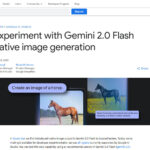Another week full of news, updates and innovations from the world of AI for you: Google’s AI projects are now called Gemini, a new star in the open source AI sky and YouTube’s big plans for 2024.
Google is betting on Gemini: a new age of AI

Google has unified its AI strategy by combining all previous AI products under the new name “Gemini”. This includes the redesign of the Bard chatbot to Gemini, the launch of a dedicated Android app and the integration of Duet AI features into Google Workspace. Gemini Ultra 1.0, the most advanced model, is made available to the public. Gemini positions itself as a central part of Google’s future, with the intention of providing more comprehensive, multimodal and helpful AI assistance.
| Key Point | New description |
|---|---|
| New name | Google is consolidating its AI under the name Gemini. |
| Platforms | Android app available; iOS access via Google App. |
| Gemini Ultra 1.0 | Public gets access to the most advanced model. |
| Subscription | Gemini Ultra available via Google One AI Premium subscription. |
| Vision for the future | Gemini as a central part of Google’s AI strategy and vision for an AI future. |
Link: https://www.theverge.com/2024/2/8/24065553/google-gemini-ios-android-app-duet-bard
Smaug-72B: The new star in the open source AI sky

Smaug-72B, developed by Abacus AI, sets new standards in the world of open source AI. This model, which is based on Qwen-72B, not only outperforms its predecessors such as GPT-3.5 and Mistral Medium in several benchmarks, but also establishes itself as the first open source model with an average score of over 80 on the Hugging Face Open LLM ranking. Its strengths lie particularly in logic and math tasks, which was achieved through special fine-tuning techniques.
| Key Point | Key Point Description |
|---|---|
| Developer | Abacus AI |
| Base model | Improvement of Qwen-72B |
| Performance | Outperforms GPT-3.5 and Mistral Medium |
| Rating | First open source model over 80 on Hugging Face |
| Strengths | Logic and math |
Link: https://venturebeat.com/ai/meet-smaug-72b-the-new-king-of-open-source-ai/
YouTube’s big plans for 2024: A letter from CEO Neal Mohan

In an open letter, YouTube CEO Neal Mohan outlines four strategic priorities for 2024, including using AI to support creative content, recognizing content creators as new media moguls, extending the YouTube experience into the living room and promoting subscription services, and securing the creator economy through improved protection and support for creators.
| Key Point | Description |
|---|---|
| Generative AI to boost creativity | Neal Mohan emphasizes how generative AI will expand creativity and open up new opportunities for creators. |
| Creators as the next generation of studios | Recognizing creators as key players in the digital content landscape. |
| Expansion into the living room and subscriptions | YouTube plans to increase its presence in living rooms and expand its subscription offering. |
| Protecting the creator economy | A fundamental commitment to safeguarding economic opportunities for creators. |
Link: https://blog.youtube/inside-youtube/2024-letter-from-neal/
Revolution in antiquity research: AI enables reading of ancient scrolls

Researchers have used AI technology to decipher the text of a scroll charred during the eruption of Mount Vesuvius in 79 AD. An international team won the $700,000 grand prize of the Vesuvius Challenge by reading more than 2000 Greek letters from the scroll. This discovery marks a turning point in the understanding of ancient texts and could revolutionize the field of papyrology.
| Key Point | Key Point Description |
|---|---|
| Breakthrough thanks to AI | Researchers used AI to decipher the text of a scroll charred by the eruption of Vesuvius. |
| The Vesuvius challenge | A competition with prize money of 1 million dollars led to the deciphering of the text. |
| International cooperation | A team of students from Germany, the USA and Switzerland won the main prize. |
| Significance for science | The discovery could usher in a new era in the understanding of ancient texts. |
| Technological innovations | The development of algorithms for the digital unrolling of the scrolls and for ink recognition. |
Link: https://www.theguardian.com/science/2024/feb/05/ai-helps-scholars-read-scroll-buried-when-vesuvius-erupted-in-ad79
First deepfake scam in Hong Kong: company loses 25 million dollars

A Hong Kong company fell victim to a deepfake scam and lost 25 million dollars. Fraudsters used deepfake technology to simulate the chief financial officer and other employees in a video conference and induced an employee to transfer the funds. This incident is the first of its kind in Hong Kong to use deepfake technology on such a scale.
| Key Point | Description of the case |
|---|---|
| Unique fraud case | A Hong Kong company lost 25 million dollars in a deepfake scam. |
| Technology behind the fraud | Fraudsters used deepfake to simulate the CFO and other employees in a video conference. |
| Discovery and investigation | The scam was discovered after a week and the Hong Kong police are investigating. |
| Prevention tips | The police recommend methods for verifying the authenticity of people in video conferences. |
Link: https://arstechnica.com/information-technology/2024/02/deepfake-scammer-walks-off-with-25-million-in-first-of-its-kind-ai-heist/
OpenAI’s Sam Altman seeks up to $7 trillion for AI chip project

OpenAI CEO Sam Altman is seeking an investment of up to $7 trillion to revolutionize the global semiconductor industry and increase the production of AI chips. This ambitious project aims to boost OpenAI’s growth, which is limited by the current shortage of AI chips. Altman is in negotiations with several investors, including the government of the United Arab Emirates.
| Key Point | Description of the project |
|---|---|
| Transforming the semiconductor industry | OpenAI CEO Sam Altman plans to revolutionize the global semiconductor industry with trillions in investment. |
| Seeking funding | Altman is in talks with investors, including the government of the United Arab Emirates. |
| Project scope | Between 5 and 7 trillion dollars could be needed for the project. |
| AI infrastructure expansion | The goal is to increase the global capacity for building AI chips and boost OpenAI’s growth. |
Link: https://www.cnbc.com/2024/02/09/openai-ceo-sam-altman-reportedly-seeking-trillions-of-dollars-for-ai-chip-project.html
Hugging Face unveils open-source AI assistant to rival OpenAI’s GPTs

Hugging Face has introduced Hugging Chat Assistants, an open-source alternative to OpenAI’s custom GPTs that allows users to create their own AI chatbots for free. Unlike OpenAI’s paid offering, users can choose from different open-source language models, increasing customization and accessibility.
| Key Point | Product description |
|---|---|
| Product launch | Hugging Face introduces customizable Hugging Chat Assistants, a free alternative to OpenAI’s GPT Builder. |
| Ease of use | Creating a personalized AI chatbot is possible in two clicks, without subscription costs. |
| Model selection | Users can choose from various open source LLMs, including Mistral’s Mixtral and Meta’s Llama 2. |
| Open source approach | Hugging Face emphasizes the importance of diversity and accessibility in AI development. |
Link: https://venturebeat.com/ai/hugging-face-launches-open-source-ai-assistant-maker-to-rival-openais-custom-gpts/
OpenAI develops ChatGPT for device control

OpenAI is working on an innovative version of ChatGPT that can use physical devices, which could change the landscape of intelligent assistants. This project raises significant privacy and security issues.
| Key Point | Key Point Description |
|---|---|
| New product from OpenAI | OpenAI is working on an AI assistant capable of operating devices. |
| Expansion of AI capabilities | This development could revolutionize traditional smart assistants. |
| Data protection and security concerns | The technology raises questions about data protection and security. |
Link: https://cointelegraph.com/news/open-ai-working-on-artificial-intelligence-chat-gpt-use-devices
Midjourney strengthens hardware team with former Apple Vision Pro engineer

Midjourney has hired Ahmad Abbas, an experienced Apple Vision Pro engineer, to lead its hardware initiatives. This signals exciting developments in Midjourney’s generative AI and hardware.
| Key Point | Key Point Description |
|---|---|
| New addition to Midjourney | Ahmad Abbas, former hardware engineer at Apple, is now leading hardware development at Midjourney. |
| Background of the new hire | Abbas was involved in the development of the Apple Vision Pro. |
| Significance for Midjourney | This points to ambitious hardware projects at Midjourney, possibly in the field of generative AI. |
Link: https://www.benzinga.com/news/24/02/36963263/midjourney-hires-apple-vision-pro-engineer-to-lead-its-hardware-ambitions
DALL-E 3 introduces C2PA metadata: A step towards ensuring digital authenticity

OpenAI integrates C2PA metadata into DALL-E 3 to improve the traceability and authenticity of images. This initiative marks an important step towards transparency and trustworthiness of generated media content. The metadata makes it easier to verify the origin of images, although their removal is possible through certain actions such as uploading to social media.
| Key Point | Key Point Description |
|---|---|
| C2PA metadata integration | Improves the verifiability and authenticity of generated images. |
| Availability | Affects images generated via web and API, with planned extension for mobile users. |
| Restrictions | Metadata can be removed by certain actions, such as uploading to social media. |
Link: https://help.openai.com/en/articles/8912793-c2pa-in-dall-e-3
Meta introduces labeling for AI-generated images on Facebook, Instagram and Threads

Meta plans to label images on Facebook, Instagram and Threads that are recognized as AI-generated. This initiative, developed in collaboration with industry partners, aims to create transparency and inform users when content has been created by AI. The “Imagined with AI” label is applied to photorealistic images generated with Meta AI and will be extended to content from other companies.
| Key Point | Description of the |
|---|---|
| Industry standards for AI content | Collaboration with partners to develop common standards for labeling AI content. |
| Labeling of AI-generated images | Meta will label images with “Imagined with AI” to give users clarity about the origin. |
| Expansion of transparency | Meta is working on recognizing AI-generated content beyond images, including audio and video. |
Link: https://about.fb.com/news/2024/02/labeling-ai-generated-images-on-facebook-instagram-and-threads/
Microsoft revolutionizes Copilot with AI image generation and new Deucalion model

Microsoft has updated Copilot with new features for AI image generation and the brand new AI model Deucalion. These innovations provide users with improved image editing and creation capabilities and signal a significant advance in the integration of generative AI into everyday applications. In particular, Deucalion improves Copilot’s “Balanced Mode”, resulting in faster and richer responses.
| Key Point | Description |
|---|---|
| New AI features in Copilot | Introduction of image generation and editing functions. |
| Introduction of Deucalion | A new AI model that specifically improves Copilot’s Balanced Mode. |
| Improvements and accessibility | Copilot is now publicly available and offers improved features for creative and precise requests. |
Link: https://venturebeat.com/ai/microsoft-brings-ai-image-generation-to-copilot-adds-new-model-deucalion/
Stability AI presents SVD 1.1 for more consistent AI videos

Stability AI has introduced SVD 1.1, an optimized diffusion model for creating more consistent AI videos. SVD 1.1 improves motion quality and consistency in short videos, based on a still image, and is publicly available via Hugging Face. It promises a significant improvement over previous models by providing more realistic motion and visual quality.
| Key Point | Description |
|---|---|
| SVD 1.1 release | An upgrade to the latent diffusion model for more consistent AI-generated video. |
| Availability and access | Publicly available via Hugging Face, with different subscription levels for commercial use. |
| Improvements over predecessors | Provides more realistic motion and visual consistency in videos. |
Link: https://venturebeat.com/ai/stability-ai-launches-svd-1-1-a-diffusion-model-for-more-consistent-ai-videos/
Apple unveils MGIE: Revolution in AI-powered image editing

Apple has unveiled MGIE (MLLM-Guided Image Editing), an innovative AI model that allows users to make image edits using simple text instructions. This development, a collaboration with the University of California, Santa Barbara, allows users to crop, resize, rotate and add filters to photos without using image editing software. MGIE is publicly available on GitHub and via a web demo on Hugging Face Spaces.
| Key Point | Key Point Description |
|---|---|
| Simple and complex edits | MGIE enables both simple and complex image editing through text input. |
| Availability | Available for download on GitHub and as a web demo on Hugging Face Spaces. |
| Future plans unclear | Apple has not announced any specific plans for the model beyond research purposes. |
Link: https://www.theverge.com/2024/2/7/24065125/apple-generative-ai-image-editing-mgie-open-source-model







